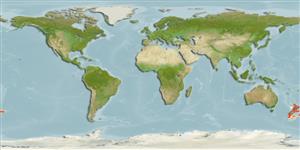Environment: milieu / climate zone / depth range / distribution range
Ecología
marino demersal; rango de profundidad 30 - 600 m (Ref. 58489). Temperate; 34°S - 52°S, 158°E - 174°W
Southwest Pacific: endemic to New Zealand.
Length at first maturity / Tamaño / Peso / Age
Maturity: Lm 47.5, range 45 - 50 cm
Max length : 90.0 cm TL macho / no sexado; (Ref. 9988); common length : 46.0 cm TL macho / no sexado; (Ref. 9049); edad máxima reportada: 20 años (Ref. 9072)
Short description
Claves de identificación | Morfología | Morfometría
Radios blandos dorsales (total) : 17 - 19; Radios blandos anales: 17 - 18; Vértebra: 33 - 34. This species is distinguished by the following characters: D 17-19; A 17-18; vertebrae 33-34; body rather elongate, tapering from a moderately broad, flat, bony head (width 1.1-1.4 times its length) covered with tiny blunt spines in juveniles to low radiating ridges in adults; small eyes directed upwards; bony orbital rim separated medially by naked rectangular space; mouth large, vertical, with several prominent canines between smaller canines; chin smooth; lips with short ridge-like crenulations; ventral margin of preopercle with four spine-like processes; anterior end of isthmus with a pair of prominent forward directed spines; prominent cleithral spine sheathed with skin above pectoral fin base; gill rakers on first arch 14-17, in the form of patches of fine teeth, patches narrow, teeth in three or four rows, innermost row rather long; no scales; lateral line pores in skin high on side close to base of dorsal fin; dorsal fin low, elongate, its base 67-82% of predorsal length; pectoral fins huge, fan-like; pelvic fins moderately large, length 20-25% SL (Ref. 86516).
Reported from depths between 30 m (Ref. 58489) and 600 m (Ref. 9258). Buries in sea bed until suitable prey passes by. Utilized fresh and frozen; can be steamed, broiled and baked (Ref. 9988).
Life cycle and mating behavior
Madurez | Reproducción | Puesta | Huevos | Fecundidad | Larva
Armitage, R.O., D.A. Payne, G.J. Lockley, H.M. Currie, R.L. Colban, B.G. Lamb and L.J. Paul (eds.), 1994. Guide book to New Zealand commercial fish species. Revised edition. New Zealand Fishing Industry Board, Wellington, New Zealand, 216 p. (Ref. 9258)
IUCN Red List Status (Ref. 130435: Version 2024-1)
Threat to humans
Harmless
Human uses
Pesquerías: comercial
Herramientas
Special reports
Download XML
Fuentes de Internet
Estimates based on models
Preferred temperature (Ref.
123201): 7.8 - 14.3, mean 11.2 °C (based on 62 cells).
Phylogenetic diversity index (Ref.
82804): PD
50 = 0.5020 [Uniqueness, from 0.5 = low to 2.0 = high].
Bayesian length-weight: a=0.01259 (0.00660 - 0.02400), b=3.02 (2.85 - 3.19), in cm total length, based on LWR estimates for this species & (Sub)family-body (Ref.
93245).
Nivel trófico (Ref.
69278): 4.2 ±0.58 se; based on food items.
Resiliencia (Ref.
120179): Medio, población duplicada en un tiempo mínimo de 1.4-4.4 años (tm=3; tmax=20).
Prior r = 0.34, 95% CL = 0.22 - 0.51, Based on 1 full stock assessment.
Fishing Vulnerability (Ref.
59153): Moderate to high vulnerability (51 of 100).
Climate Vulnerability (Ref.
125649): High to very high vulnerability (71 of 100).
Nutrients (Ref.
124155): Calcium = 20.6 [14.1, 37.8] mg/100g; Iron = 0.324 [0.212, 0.523] mg/100g; Protein = 18.7 [17.9, 19.5] %; Omega3 = 0.679 [0.432, 1.032] g/100g; Selenium = 20.5 [11.4, 37.8] μg/100g; VitaminA = 16.4 [5.6, 49.6] μg/100g; Zinc = 0.368 [0.278, 0.500] mg/100g (wet weight);
